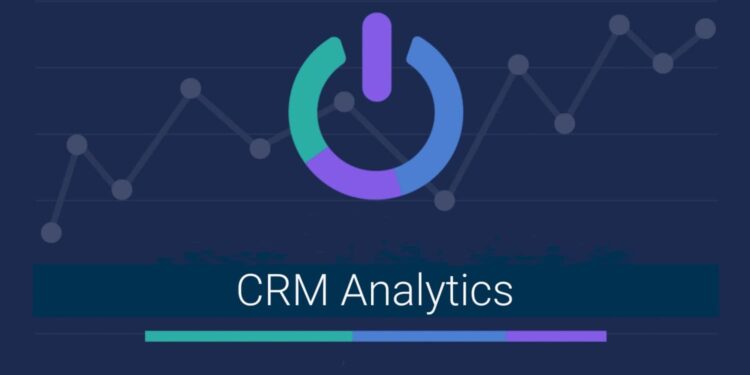Unlocking the potential of CRM analytics is like peering into a crystal ball for businesses, revealing insights that can transform customer relations and boost profitability. Brace yourself for a journey through the world of data-driven strategies and customer-centric solutions.
CRM analytics is a game-changer in today's competitive landscape, offering a roadmap to success through informed decision-making and personalized experiences.
Introduction to CRM Analytics
CRM analytics refers to the process of analyzing customer data to improve relationships, enhance customer satisfaction, and drive business profitability. By utilizing advanced analytics tools, companies can gain valuable insights into customer behavior, preferences, and trends, allowing them to make data-driven decisions that positively impact their bottom line.CRM analytics play a crucial role in helping companies understand their customers better and tailor their products and services to meet their needs effectively.
By analyzing data from various touchpoints such as sales, marketing, and customer service, organizations can identify patterns, predict future trends, and personalize interactions to enhance the overall customer experience.
Industries Benefiting from CRM Analytics
- Retail: Retailers use CRM analytics to segment customers based on purchasing behavior, create targeted marketing campaigns, and optimize inventory management.
- Financial Services: Banks and financial institutions leverage CRM analytics to personalize offers, detect fraud, and improve customer retention.
- Telecommunications: Telecom companies utilize CRM analytics to improve customer service, reduce churn rates, and enhance cross-selling opportunities.
- E-commerce: Online retailers rely on CRM analytics to analyze customer browsing patterns, recommend products, and optimize pricing strategies.
Key Components of CRM Analytics
CRM analytics involves various essential components that play a crucial role in understanding customer behavior and enhancing business strategies. These components include data collection, data integration, data analysis, reporting, predictive analytics, and data visualization tools.
Data Collection
Data collection is the initial step in CRM analytics, where relevant customer information is gathered from various sources such as CRM systems, social media platforms, and website interactions. This data forms the foundation for further analysis and decision-making.
Data Integration
Data integration involves combining data from different sources into a unified view to ensure consistency and accuracy. By integrating data effectively, businesses can create a comprehensive customer profile and gain a holistic understanding of customer interactions.
Data Analysis
Data analysis is the process of examining and interpreting data to extract valuable insights. Through statistical analysis, data mining, and machine learning techniques, businesses can uncover patterns, trends, and relationships within the data to make informed decisions.
Reporting
Reporting in CRM analytics involves presenting the analyzed data in a clear and concise manner. Reports help businesses track key performance indicators, monitor customer satisfaction, and evaluate the effectiveness of marketing campaigns.
Predictive Analytics
Predictive analytics uses historical data and statistical algorithms to forecast future trends and behaviors. By predicting customer preferences, buying patterns, and churn rates, businesses can proactively address customer needs and tailor their strategies accordingly.
Data Visualization Tools
Data visualization tools such as dashboards, charts, and graphs help transform complex data into visual representations that are easy to understand. By visually presenting CRM analytics data, businesses can identify trends, outliers, and correlations at a glance, facilitating quicker and more informed decision-making.
Implementing CRM Analytics
Implementing CRM analytics in a company can be a game-changer when done effectively. Here are some steps to help you implement CRM analytics successfully:
Steps to Implement CRM Analytics:
- Define your goals and objectives: Clearly Artikel what you want to achieve with CRM analytics, whether it's improving customer satisfaction, increasing sales, or enhancing marketing campaigns.
- Assess your data: Evaluate the quality and quantity of your data to ensure it is clean, organized, and relevant for analysis.
- Select the right CRM analytics software: Compare different CRM analytics software available in the market based on features, scalability, ease of use, and integration capabilities.
- Train your team: Provide training to your employees on how to use the CRM analytics tools effectively and interpret the data to make informed decisions.
- Start small and scale up: Begin with a pilot project to test the effectiveness of CRM analytics in a specific area before scaling up across the organization.
- Monitor and measure results: Continuously monitor the performance of your CRM analytics initiatives and measure the impact on key metrics to make necessary adjustments.
Challenges and Solutions in Implementing CRM Analytics:
- Integration issues: Challenges may arise when integrating CRM analytics software with existing systems. Ensure proper planning and communication between IT and business teams to overcome integration hurdles
.
- Data privacy concerns: Organizations need to address data privacy regulations and ensure the security of customer information when implementing CRM analytics. Implement robust data protection measures and obtain necessary consent from customers.
- Lack of user adoption: Some employees may resist using CRM analytics tools due to lack of training or understanding of its benefits. Provide adequate training and support to encourage user adoption and demonstrate the value of CRM analytics.
- Limited budget and resources: Implementing CRM analytics may require a significant investment in software, training, and resources. Develop a clear budget plan and prioritize investments based on the expected ROI to overcome budget constraints.
Benefits of CRM Analytics
CRM analytics offer a wide range of benefits for businesses looking to enhance customer relationships and drive growth. By leveraging data and insights, organizations can improve customer retention, personalize marketing strategies, and streamline sales processes for increased efficiency.
Enhanced Customer Retention and Loyalty
- CRM analytics provide valuable insights into customer behavior, preferences, and interactions, allowing businesses to identify at-risk customers and proactively address their needs.
- By analyzing data on customer satisfaction and engagement, organizations can tailor their approach to meet individual preferences, leading to increased loyalty and repeat business.
- Through targeted marketing campaigns and personalized communication, businesses can strengthen relationships with customers and enhance their overall experience, resulting in higher retention rates.
Personalized Marketing Strategies
- CRM analytics enable businesses to segment customers based on demographics, purchasing history, and engagement levels, allowing for the creation of personalized marketing campaigns that resonate with specific target audiences.
- By understanding customer preferences and behavior patterns, organizations can deliver relevant and timely offers, promotions, and content, leading to higher engagement and conversion rates.
- Personalized marketing strategies can help businesses build stronger connections with customers, increase brand loyalty, and drive long-term profitability.
Streamlined Sales Processes and Improved Efficiency
- CRM analytics provide insights into sales performance, customer interactions, and pipeline management, enabling businesses to identify opportunities for process improvement and optimization.
- By automating routine tasks, tracking key metrics, and forecasting sales trends, organizations can streamline their sales processes, reduce manual effort, and enhance productivity.
- Improved efficiency in sales operations leads to faster response times, better resource allocation, and higher conversion rates, ultimately driving revenue growth and profitability.
Best Practices in CRM Analytics
Implementing best practices in CRM analytics is crucial for maximizing the effectiveness of your customer relationship management strategies. By ensuring data hygiene, quality assurance, continuous monitoring, and optimization, businesses can extract valuable insights to enhance customer relationships and drive growth.
Data Hygiene and Quality Assurance
One of the best practices in CRM analytics is maintaining data hygiene and ensuring data quality assurance. This involves regularly cleaning and updating customer data to eliminate duplicates, inconsistencies, and inaccuracies. By maintaining clean and accurate data, businesses can make informed decisions based on reliable information.
Continuous Monitoring and Optimization
Continuous monitoring and optimization play a vital role in CRM analytics strategies. Businesses should regularly track key performance indicators (KPIs), analyze trends, and identify areas for improvement. By continuously optimizing CRM analytics strategies, businesses can adapt to changing market conditions and customer preferences to stay competitive.
Successful CRM Analytics Implementations
Successful CRM analytics implementations involve a combination of robust data infrastructure, advanced analytics tools, and a customer-centric approach. For example, companies like Amazon and Netflix have leveraged CRM analytics to personalize customer experiences, recommend products, and improve customer retention. These companies utilize predictive analytics, machine learning algorithms, and real-time data processing to deliver personalized and targeted marketing campaigns.
Conclusion
As we wrap up our exploration of CRM analytics, remember that harnessing data is not just a trend but a necessity for companies looking to thrive in a customer-centric era. By leveraging CRM analytics effectively, businesses can create lasting relationships, drive sales, and stay ahead of the curve in a dynamic market.
Detailed FAQs
How can CRM analytics benefit my business?
CRM analytics can help enhance customer relationships, boost profitability, and tailor marketing strategies for better engagement.
What are the key components of CRM analytics?
The essential components include data collection, integration, analysis, reporting, and predictive analytics for forecasting customer behavior.
What challenges might organizations face when implementing CRM analytics?
Common challenges include data integration issues, lack of proper training, and resistance to change. Overcoming these hurdles requires a strategic approach and effective communication.





